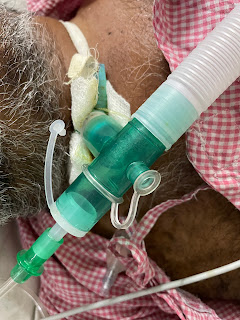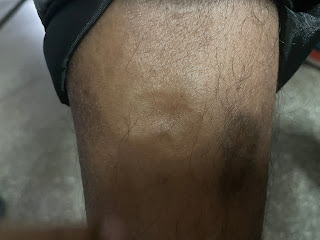57 YEAR OLD MALE WITH CHEIF COMPLAINTS OF FEVER, ALTERED SENSORIUM FROM 1 MONTH
This is an online e log book to discuss our patient de-identified health data shared after taking his / her / guardians signed informed consent. Here we discuss our individual patients problems through series of inputs from available global online community of experts with an aim to solve those patients clinical problem with collective current best evident based input.
This E blog also reflects my patient centered online learning portfolio and your valuable inputs on the comment box is welcome.
I have been given this case to solve in an attempt to understand the topic of " patient clinical data analysis" to develop my competency in reading and comprehending clinical data including history, clinical findings, investigations and come up with diagnosis and treatment plan.
A 57-year-old male resident of Nalgonda security guard by
occupation came with the chief complaints of fever since 1-month, generalised
weakness since 1 month and altered sensorium 1 month back for 3 days.
HISTORY OF PRESENTING ILLNESS
Patient developed generalised weakness 1 month with blurring
of vision which was insidious on onset not progressive, after 2 days he developed
fever which was 103 degrees. Fever was insidious in onset, gradually
progressive no aggravating and relieving factors known. After two days of onset
of fever he suddenly fell in bathroom due to weakness in legs and hurt his
head. Upon approaching the patient family observed slurring of speech. He was
then taken to government hospital. He approached the car by himself walking with
the help of a stick during the travel to hospital he showed symptoms of altered
sensorium where he was responding lately. He was kept in ward and treated only with
glucose without any medications. He was then taken to a private hospital where
his condition worsened and was unable to remember things which happened 10 mins
back and could not recognise anyone except his elder daughter. As he was being
taken to MRI, he lost consciousness and completely stopped responding. MRI was
taken and high dose antibiotics were given where he regained consciousness and
could slowly start recognizing his family members. There he was treated strong
enough to transport to our hospital. They did an elective tracheostomy and sent
him to our hospital. Upon reaching our hospital CSF analysis were done and treatment
was started. Fever subsided completely and he was afebrile for a week. After a
week into the treatment, he developed shortness of breath, he started
developing pneumothorax to which a inter coastal drainage tube was placed. He was
on ventilator for some time after this episode. Later 3 days after pneumothorax
the patient developed a bed sore and along with-it developed fever. This time
it was continuous gradually progressive relieved on medication. Upon history he
said that he had a surgery for cervical spondylosis 4 years back. After the
surgery he could not bear the fan and could not sleep directly in its wind. It
gradually increased and reached to a level of high discomfort 2 months back. He
had history of constipation for 10 days 1 month back where enema was done in
the private hospital. He never had free bowel movements and had problem since a
long time. Upon history taking there was another finding of sound during
respiration from 1month before the onset of generalised weakness it increased
gradually and was not seen after tracheostomy. There was history of rolling
over of eyes during MRI scan in the private hospital. There is no history of
involuntary movements, seizures, involuntary micturition, or defaecation. No
history of vomiting.
PAST HISTORY
He was diagnosed with cervical spondylosis and lumbar
spondylosis 4 years back upon which he was advised for surgery for cervical
spondylosis and normal conservational treatment for lumbar spondylosis. After the
surgery he was bed ridden for 6 months. Before diagnosis he had muscle
tightness in his peripheral muscles which was relieved after surgery. Later the
lumbar spondylosis worsened and upon approaching doctors the said that he would
be unable to walk after operation so they didn’t go through with the operation.
He is a known hypertensive from 7 years and was not on medication regularly thinking
about his financial status. Not a known case of diabetes, Tuberculosis, epilepsy,
coronary artery disease.
PERSONAL HISTORY
Diet: Mixed
Apetite: Normal
Bowel movements: Decreased
Bladder movements: Normal
Drinks toddy occasionally
No history of tobacco, smoking
FAMILY HISTORY
No similar complaints in the family
GENERAL EXAMINATION
Patient is conscious, coherent and cooperative. Moderately
built and nourished
No pallor, icterus, cyanosis, clubbing, generalized lymphadenopathy, pedal edema.
VITALS
Temperature: 103 C
Blood pressure:130/90 mmHg
Pulse rate: 96 bpm
Respiratory rate: 24 cpm
THORACOCENTESIS
SYSTEMIC EXAMINATION
CARDIOVASCULAR EXAMINATION
S1, S2 heard. No murmurs
RESPIRATORY EXAMINATION
Chest symmetrical, normal vesicular breath sounds heard, no
additional breath sounds
ABDOMEN
Abdomen is soft, non-tender, no organomegaly
CENTRAL NERVOUS SYSTEM EXAMINATION
Higher mental functions: Intact
CRANIAL NERVES
Olfactory: Normal
Optic: Normal
Oculomotor, trochlear and abducens: Normal
Trigeminal: Normal
Facial: Normal
Vestibulocochlear: Normal
Glossopharyngeal, vagus: Normal
Spinal accessory: Normal
Hypoglossal: Normal
MOTOR FUNCTIONS
Bulk: Normal in all four limbs
Tone: Normal in all four limbs
Power: Upper limb left 4/5, Upper limb right 4/5
Lower limb left 4/5, Lower limb right 4/5
Neck muscles good
Trunk muscles good
Plantar reflex present on
both sides
Reflexes: Superficial reflexes: Corneal, conjunctival, pharyngeal: Present
Deep tendon reflexes: Biceps
reflex 2+ on both sides
Triceps reflex 2+ on both sides
Supinator jerk 2+ on both sides
Knee jerk
2+ on both sides
Ankle jerk 2+ on both sides
Coordination tested along with cerebellum normal
No involuntary movements
SENSORY SYSTEM
Spinothalamic: Crude touch, pain, temperature normal on both
sides on all limbs
Posterior column: Fine touch, Vibration, Position sense present on all limbs
Cortical: Two-point discrimination, Tactile localisation, Graphesthesia,
Stereognosis normal
CEREBELLAR SIGNS
No nystagmus, coordination intact in upper and lower limbs, hypotonia
absent
NO SIGNS OF MENINGEAL IRRITATION (Neck stiffness, kernig’s
sign, Brudzinski sign)
No thickened nerves in periphery, trophic ulcers, wrist drop
or foot drop
DIAGNOSIS
CVA with acute ischemic stroke (infarct in cortical and subcortical regions of occipital lobe) with hyponatremia (resolved) with AKI on CKD (resolved) with hypertension for past 7 years
INVESTIGATIONS



















Comments
Post a Comment